Groomsport owes its existence to the harbour which is sheltered by Ballymacormick Point, Cockle Island and the rocky outcrop where, from the time of the Vikings in the 9th century, a quay was built. The second Lifeboat in all of the province of Ulster was based in the harbour from 1858 to 1920. The quay was improved in 1902 and the building of a sea wall in the 1970s led to the provision of a dinghy park, a car park and green area around the Boathouse. In the 19th and early 20th centuries, the harbour accommodated many fishing vessels, which were owned and crewed by village residents. Today the harbour provides sheltered moorings for Cockle Island Boat Club and it is used for other water-based leisure activities.
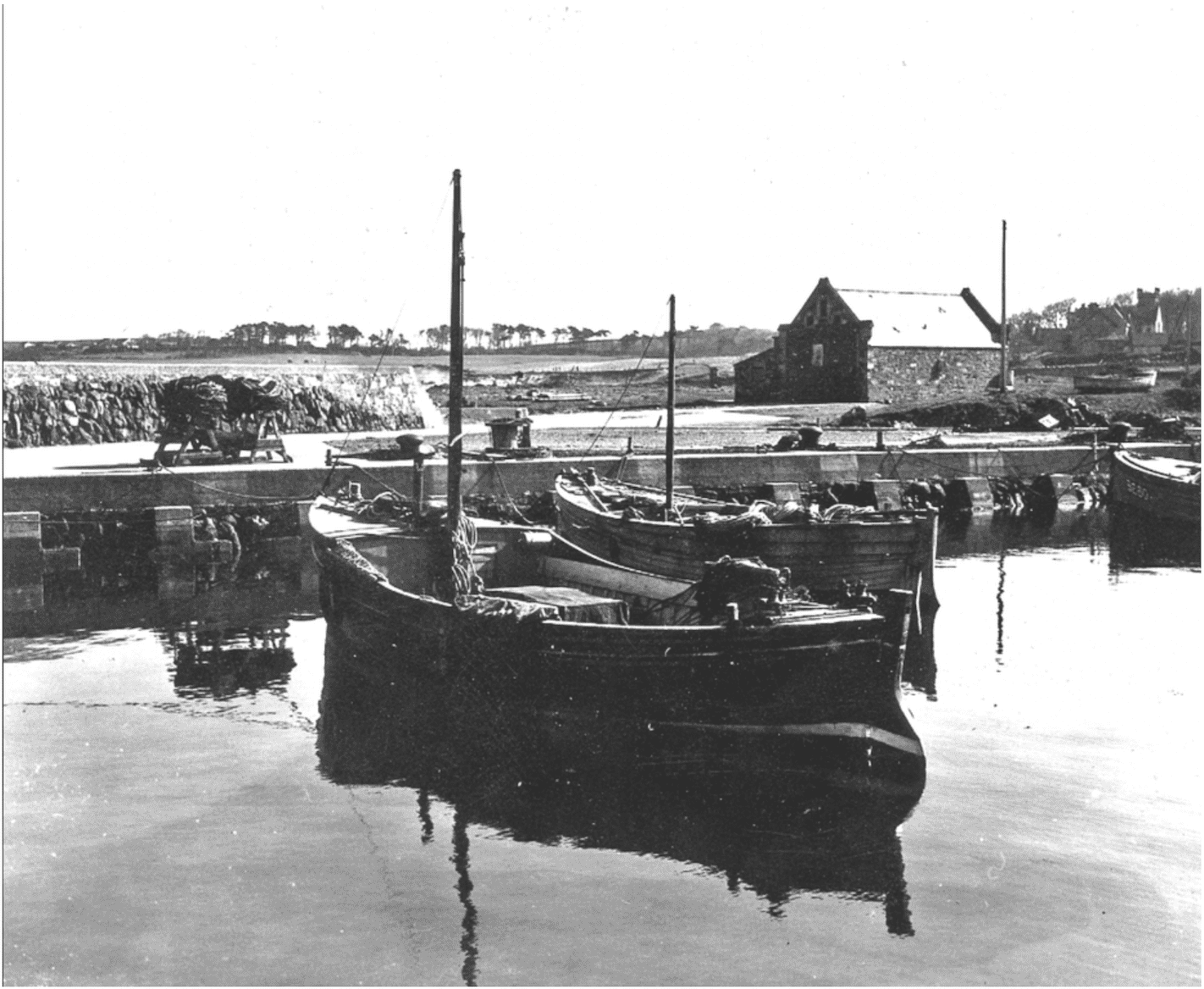


This website uses cookies to improve your experience. We\'ll assume you\'re ok with this, but you can opt-out if you wish. Read More

This photograph is of a painting by James Lawson Balfour, an Australian artist who lived in Bangor for some years in the 1890s. This painting dates from between 1895, when the second National School was built and 1900, when the artist moved to New Zealand.
It shows, on the left, the quay before it was improved in 1902. It clearly shows the cottages on Main Street, with back gardens running down to the harbour. These cottages were demolished in the 1960s. The painting also shows Cockle Row (with one cottage in ruins), the second National School, beyond the cottages, and the Presbyterian Church.
0169 Photograph of the painting taken by Peter Gibson with the permission of Lou Tinman.
For more information about the artist James Lawson Balfour, go to:
https://adb.anu.edu.au/biography/balfour-james-lawson-5114


This postcard of the harbour was taken before the harbour was renovated in 1902. It appears to be after the painting by James Lawson Balfour (0169) because the skeletal barge in Balfour’s painting seems to have disintegrated.
0237 Photograph supplied by Perry Moore.
If you have more information about this photo please contact discovergroomsport@gmail.com mentioning the four digit number above.


This is an image of an original oil painting by Groomsport-based artist, Jack Chambers.
0289 Image supplied by Jack Chambers.


This image shows Cockle Island at low tide. At high tides, the island can all but disappear. Cockle Island is a breeding ground for a number of seabirds including ArcticTerns which travel to Groomsport from the Antarctic. On a number of occasions high tides have washed nests into the sea. The National Trust, which owns the island, believes that, over time, the birds may relocate to safer nesting places on the Copeland Islands.
0005 Photograph: Amanda McWhinney


A view of the harbour which shows the Watch House before it was altered in later years, the row of Coast Guard cottages which were demolished in the 1960s and the quay, before it was improved c.1902.
0030 Photograph: Public Record Office of Northern Ireland, Perceval-Maxwell papers (D3244/E/42)


A view of the Harbour and Boathouse taken by a US soldier who was billeted for six weeks in Groomsport House in 1944. The simple original structure of the Boathouse can be seen – before it was extended and disfigured in later years.
0011 Photograph: Sgt. John Blankenhorn, 166th Signal Photographic Company, US Army


James Nixon and Ed Wheeler had sailed the Grasshopper from Ballyholme. It was one of the Insect class of dinghies which Ballyholme Yacht Club had designed for those who were learning to sail.
0015 Photograph: W M Nixon. Reproduced with permission


Notice issued by the Office of Public Works in Dublin in 1904, after the improvements had been made to the harbour.
0007 Photograph: Peter Gibson. Document in Public Record Office of Northern Ireland, Perceval-Maxwell papers (D3244/E/42)


Fishermen met and tarred their nets and ropes at the Tarred Rock. This photo shows John Waterson (1841-1922) and his dog, Diver, at the rock.
Find out more about the Waterson family at: https://discovergroomsport.com/wp-content/uploads/2024/02/Watersons-version-2.pdf
0012 Photograph reproduced with the permission of the Waterson family.


After the redevelopment of the harbour area in the 1970s, only the top of the Tarred Rock was visible. It was marked by placing an anchor on it. The origin of the anchor is not known. It was netted by a boat skippered by John Waterson, the grandson of the man who appeared in the earlier photo of the Tarred Rock. The Boathouse is seen in the background.
0013 Photograph: Peter Gibson


A view of the harbour including the Boathouse and Cockle Row Cottages. The image was taken after the improvement of the harbour (1902) and before the Lifeboat Station closed in 1920. The RNLI flag can be seen flying from the Boathouse.
0008 Photograph by Raphael Tuck Postcards. Downloaded, with permission, from: https://www.tuckdbpostcards.org/items/130156-the-harbour/picture/1


This post card, which was posted in 1909, clearly shows the improvements that were made to the harbour by Grahams of Dromore a few years earlier.
Find out more about the Coast Guard and the Watch House at: https://discovergroomsport.com/wp-content/uploads/2023/02/Coast-Guard-and-Watch-House-v3.pdf
0009 North Down Museum. Copyright Ards and North Down Council. Reproduced with permission.


This photograph shows the modern Watch House with its recent extension, clad in black wood. It also shows two earlier alterations to the house. The bay windows, which replaced the boathouse on the ground floor and the watch room on the first floor, were in place by 1944. The extension to the left of the building, facing the harbour, was subsequently added. The vestiges of the original slipway can also be seen.
Find out more about the Coast Guard and the Watch House at: https://discovergroomsport.com/wp-content/uploads/2023/02/Coast-Guard-and-Watch-House-v3.pdf
0010 Donal McCann Photography for Bradley McClure Architects. Reproduced with permission.

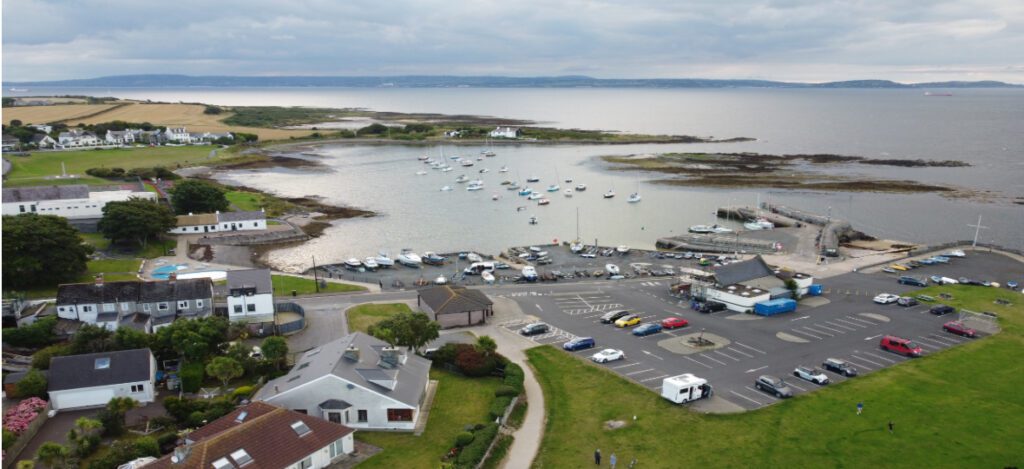
This photograph shows the harbour which is sheltered by the quay, by Cockle Island and by Ballymacormick Point. Many of the village’s notable buildings can be seen, including the Boathouse, Cockle Row cottages, the Walter Nelson Hall and the Watch House. Beyond Ballymacormick Point are Belfast Lough and County Antrim.
0004 Photograph: Amanda McWhinney

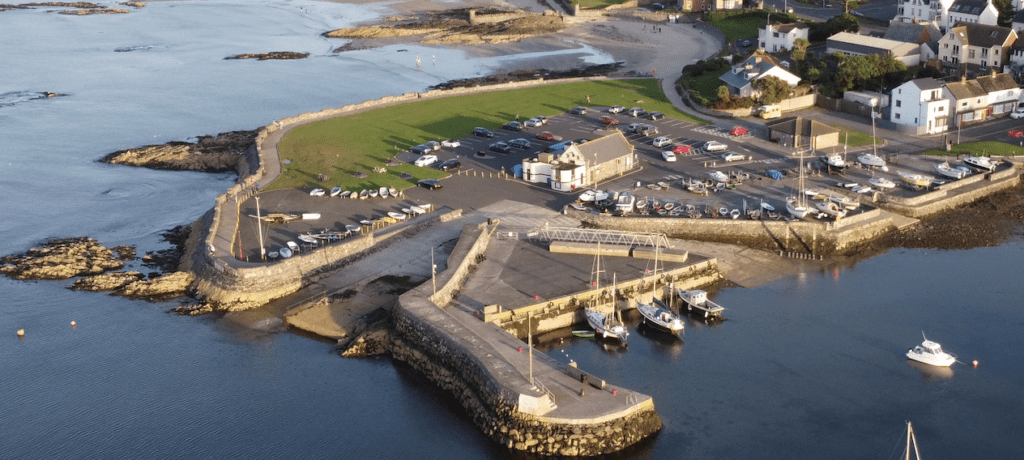
This aerial photograph gives a good view of how the harbour was developed in the 20th century. At the bottom centre of the image is the harbour which was improved by Down County Council c.1902. The Boathouse which was the Lifeboat station from 1858 to 1920 is in the centre of the image. The area around the Boathouse, including the dinghy park, the car park and the green area was created by the building of seawalls in the 1970s. At the same time, a concrete path was built from the harbour, along James Bay beach, through Perceval-Maxwell’s wall (top centre of the photo) and on to Cove Bay beach.
0014 Photograph: Amanda McWhinney


The Watch House was built in 1821 and was the Coast Guard station until 1908 when it became a private home. The cottages were built late than the Watch House and were demolished in the 1960s.
Around 1940, the nine cottages were occupied by the following, from left to right, with cottage number 9 being nearest to the Watch House:
1 Barron – Davy, Billy, George and Mary
2 Heyburn – Mary and Nanny. Bobby and Maisie Duff
3 Houston – Billy, Aggie daughters Gertie and Alice
4 Mawhinney – Jean and Sidney
5 Murphy – Sarah Murphy, her daughter, Sadie Gilbert and her children Rosemary and Johnny Gilbert
6 Nelson – Charlie and Aggie
7 Nelson – Jim, Kathleen and sons Jim, Raymond and Brian
8 Wilson – Mr and Mrs and sons Bob, George and Johnny
9 Nelson – Abel, Lily and children Hugh, Francis and Verena
0044 North Down Museum. Copyright: Ards and North Down Borough Council.
Find out more about the Coast Guard and the Watch House at:
https://discovergroomsport.com/wp-content/uploads/2023/02/Coast-Guard-and-Watch-House-v3.pdf


David Barrons (1864-1953) lived in the thatched cottage at Cockle Row.
0045 North Down Museum. Copyright: Ards and North Down Borough Council


This postcard is believed to have been taken produced about 1956.
0061 Photograph by Raphael Tuck Postcards.
Downloaded, with permission, from:
https://www.tuckdbpostcards.org/items/20624-the-harbour


This Raphael Tuck postcard is believed to have been produced about 1956.
0062 Photograph by Raphael Tuck Postcards. Downloaded, with permission, from:
https://www.tuckdbpostcards.org/items/20629-the-bay

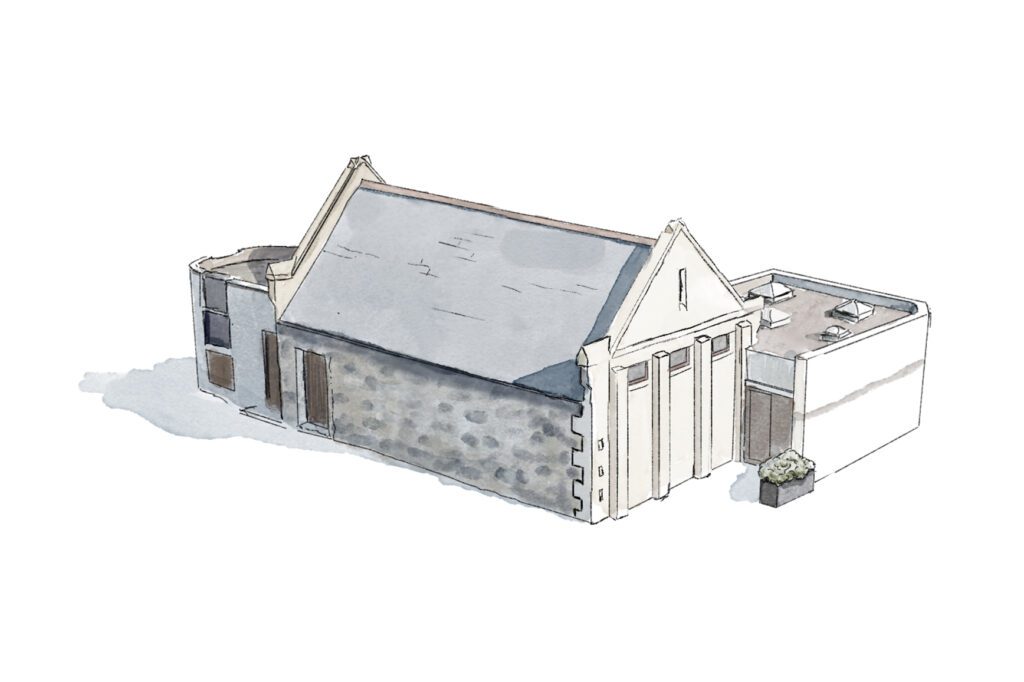
Groomsport had a lifeboat (the second in the province of Ulster) from 1858 to 1920. The Boathouse was designed by the famous architect, Sir Charles Lanyon. It is now used as the harbour office and a community hall.
0006 Copyright: Dan Parsons. https://www.parsonsart.co.uk


This photograph is thought to date from 1900s
0063 Photograph supplied by Perry Moore
If you have more information about this photo please contact discovergroomsport@gmail.com mentioning the four digit number above.


Roberta’s annotation identifies those in the photograph. Her relations were Watersons. Both Jonty Waterson and Billy Dunbar appear to be holding lobsters.
0057 Photograph supplied by Roberta Waterson Fraser and reproduced with permission.
Find out more about the Waterson family at:
https://discovergroomsport.com/wp-content/uploads/2024/02/Watersons-version-2.pdf


James Waterson (b 1852) may have served on the Lifeboat crew along with his brothers, John and Henry. Bobby Dunbar’s jersey suggests that he was employed as a crew member on a yacht based at the Royal Ulster Yacht Club in Bangor.
0056 Photograph supplied by Roberta Waterson Fraser and reproduced with permission.
Find out more about the Waterson family at:
https://discovergroomsport.com/wp-content/uploads/2024/02/Watersons-version-2.pdf


The photograph, which was taken from the tower of the Presbyterian Church, shows the shelters, the picnic area and, on the left, the Walter Nelson Hall.
0134 Photograph supplied by Rev Dr David Irwin and Mrs Maureen Irwin


Pictured are James Murray (on the right), the owner of the Trasnagh, and Jimmy Waterson who regularly skippered the yatch in competitions.
The Trasnagh was one of six Belfast Lough Island Class Gaff Yawls. In was built in 1913.
0173 Photograph supplied by Christine Scholes


0135 Photograph supplied by Rev Dr David Irwin and Mrs Maureen Irwin


The fisherman with the black cap is John Waterson.
0170 Photograph supplied by Christine Scholes


This postcard shows the Protect Me (B2) which was owned by Charlie Waterson and the AHC Waterson (B444) which was owned by John Waterson.
0172 Photograph supplied by Christine Scholes


0200 Photograph supplied by Julie Crawford
If you have more information about this photo please contact discovergroomsport@gmail.com mentioning the four digit number above.


This boat was named after Arthur Hill Coates Waterson.
Arthur Hill Coates Waterson was born on 13 May 1903 in Groomsport. After working with his father, Robert, a fisherman, for two years, he joined the Ulster Steamship Company (Headline Shipping Company) and obtained his Master Mariner ticket at the age of 21. During the Second World War Captain Arthur Waterson served with the Merchant Navy and the County Down Spectator reported that he had played a gallant part in the Dunkirk evacuation. In 1941 he was captain of SS Atheltemplar, a molasses tanker. The ship was attacked by German bomber aircraft off Aberdeenshire on 01 March 1941. Captain Arthur Waterson, who was aged 37, was among those who were killed.
0171 Photograph supplied by Christine Scholes

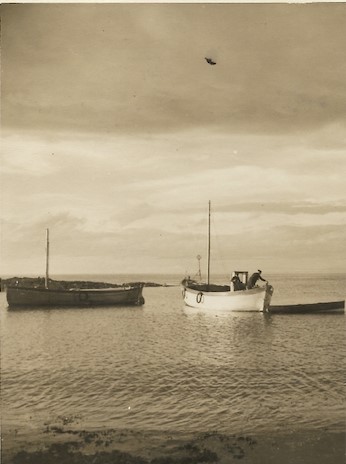
Both these boats were owned by Robert Waterson.
The Annie Waterson (on the left) was built in 1912. The Roberta, was built in 1935.
0180 Photograph supplied by Ann Blachford


On the back of this photograph is the date on which it was taken – 21st June 1938.
0183 Photograph supplied by Ann Blachford


From left to right are Thomas (‘Bunny”) Holmes, Charlie Waterson, an unknown woman and Billy Dunbar.
0247 Photograph supplied by Maureen Erskine.
If you have more information about this photo please contact discovergroomsport@gmail.com mentioning the four digit number above.


Robert is standing in front of the Boathouse.
0288 Photograph supplied by Ann Blachford


The couple were photographed on their honeymoon in Plymouth.
0250 Photograph supplied by Maureen Erskine.
If you have more information about this photo please contact discovergroomsport@gmail.com mentioning the four digit number above.

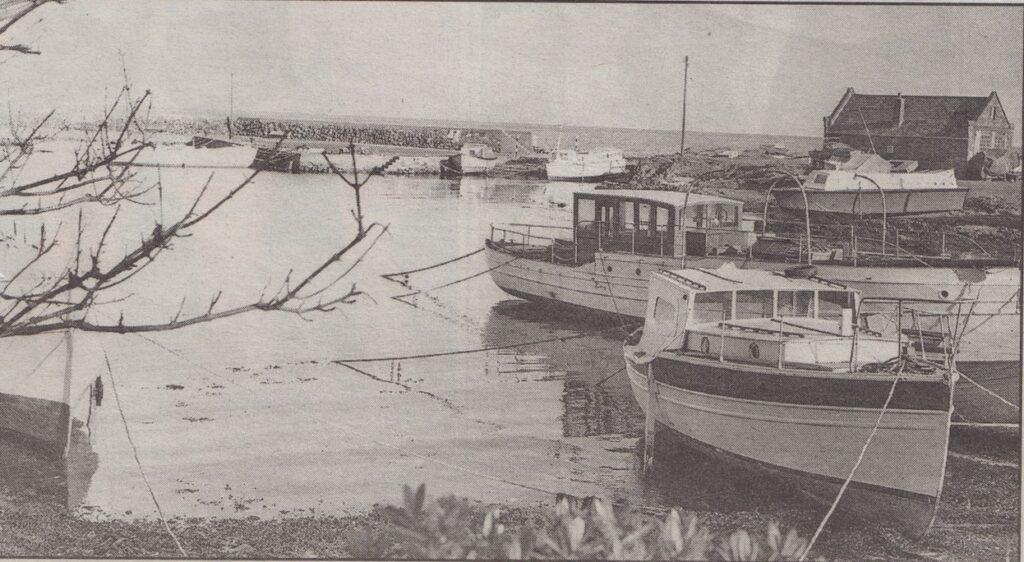
0203 Photograph supplied by Julie Crawford
If you have more information about this photo please contact discovergroomsport@gmail.com mentioning the four digit number above.

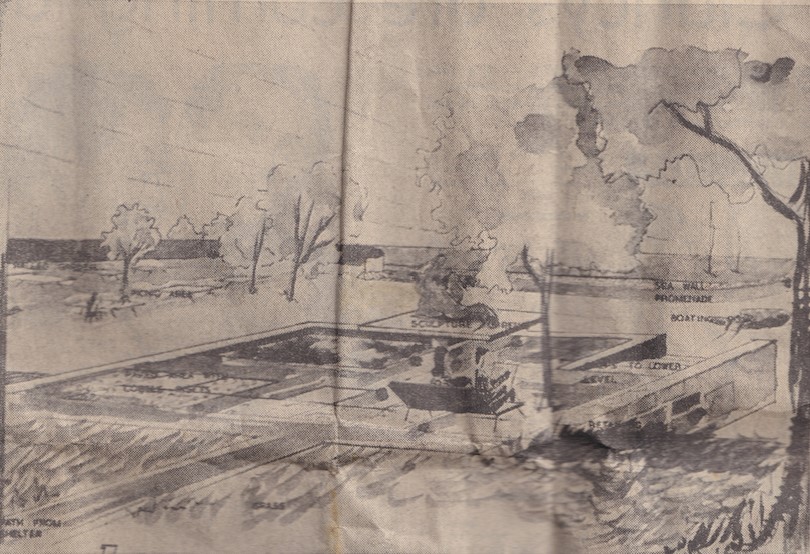
This is an artist’s impression of the proposals to redevelop the harbour area of the village. I appeared in the Belfast Telegraph on 26th February 1966, alongside the following report.
“County Down resort to get an £18,000 face-lift – Wilderness to become playground.
The centre of Groomsport, Co. Down, is to getan £18,000 “face-lift” to help attract more tourists.
Two acres of “wilderness”- covered by rocks, brambles, derelict cottages, old garages and Army huts- will be cleared to make way for public areas, paddling pool and modern shelters. The scheme will take 18 months to complete.
Mr John Pearson, deputy planning officer for Co Down, says: ‘It will remove an eyesore which ruins the whole appearance of the village’…The work is being paid for by the Government and the county council.
Other features of the improvement scheme will be an adventure playground and a small pool where children can sail their boats. The promenade will be extended almost 300 yards to enable visitors to walk right along the front”
0204 Newspaper extract supplied by Julie Crawford


This trophy was awarded to John Gunning for achieving the most points during the season. Newspaper reports mention that, in 1906, his model yacht was the Alix.
0213 Photograph by John Gunning


This medal was awarded to John Gunning (his initials are carved in the centre) for success in Tug of War.
0214 Photograph by John Gunning


This model was built by John Gunning and later restored by his son, John. The Annie Waterson was built in 1912 and was owned by Robert Waterson.
0215 Photograph by John Gunning (the grandson of the model maker).

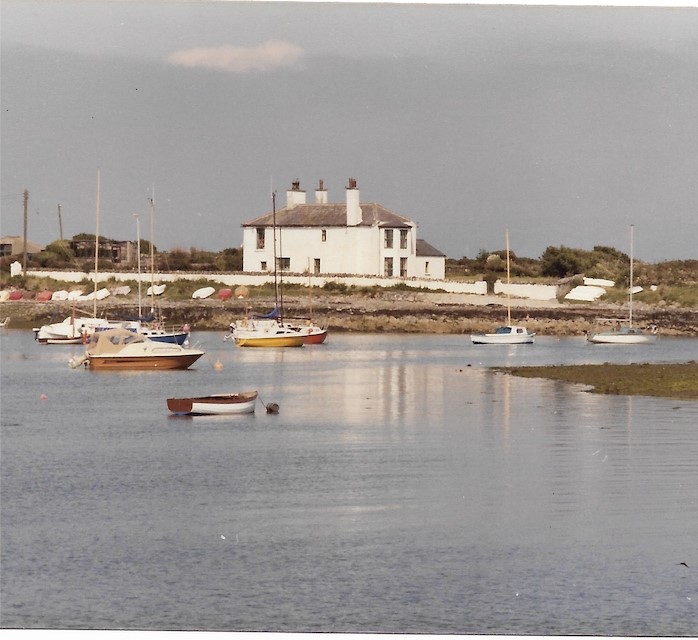
This photograph appeared on an estate agent’s brochure when the house was on the market in 1982. At that time, the extension overlooking the harbour had not been built.
0221 Photograph supplied by the Groomsport Parish Archive
Find out more about the Watch House at:
https://discovergroomsport.com/wp-content/uploads/2023/02/Coast-Guard-and-Watch-House-v3.pdf

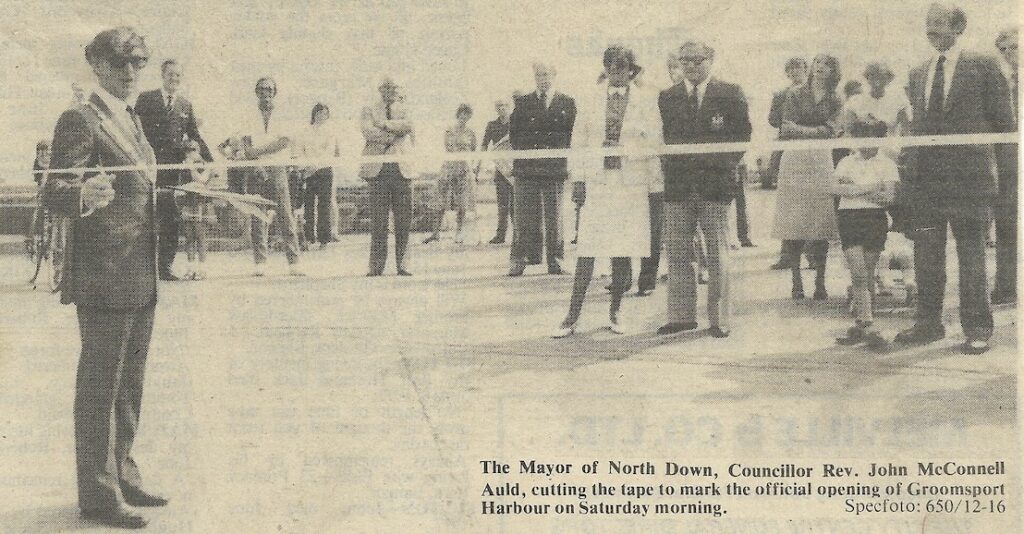
This photograph, from the County Down Spectator is accompanied by a report that notes the harbour had been dredged, and other improvements made, at a cost of £181,500. The harbour provides safe anchorage for 95 boats and can accommodate a total of 135 boats.
0222 Supplied by the Groomsport Parish Archive


This article appeared in the Belfast Telegraph on 25 January 1977. It provides some information about the work that had been carried out by Enterprise Ulster. The person beside the anchor is not named.
0223 Supplied by the Groomsport Parish Archive
If you have more information about this photo please contact discovergroomsport@gmail.com mentioning the four digit number above.


The boat is seen being towed along Quay Street, passing the bank that later became a courthouse. The date was 18th December 1935.
0217 Photograph supplied by Ann Blachford


The boat is launched off a pier in Bangor. Bobby Dunbar and John, the son of Robert Waterson, the owner of the boat, were on board as the boat was launched.
0218 Photograph supplied by Ann Blachford




These are receipted invoices for the building of the boat (£168 in total) and the purchase of its engine (£200).
Roberta would later be sold to the Nelson family and, renamed The Brothers, was based at Donaghadee, often travelling to the Copeland Islands.
0219 Photographs supplied by Ann Blachford

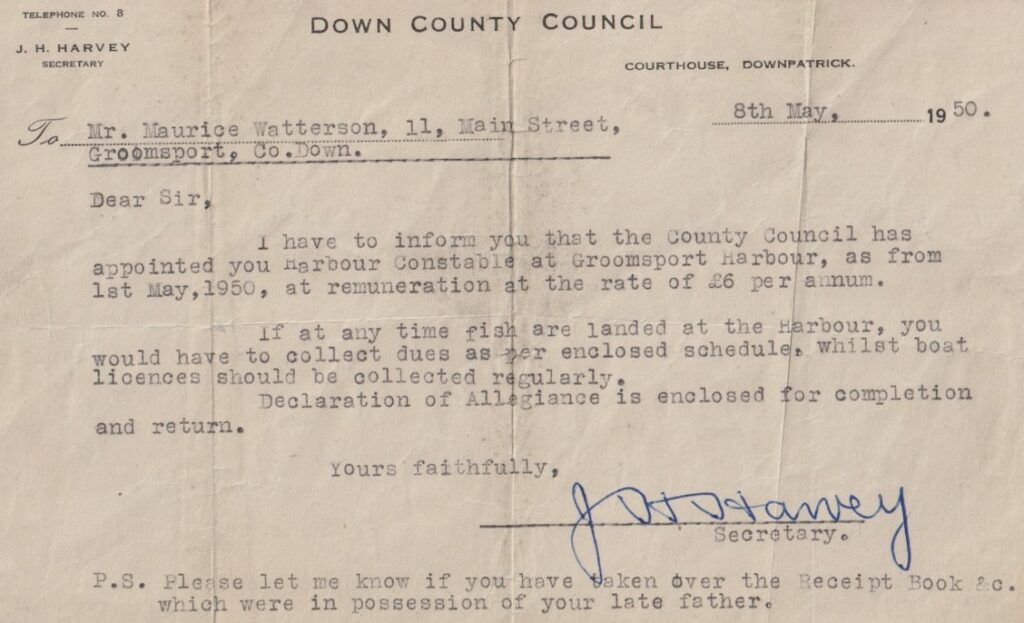
Maurice Watterson (the son of the above) has provided the following information.
Maurice Watterson held the post of Harbour Constable (usually referred to locally as “Harbour Master”) from 1950 until 1977, I believe, when ill health prevented him from continuing. It was only a part-time position and not a full-time job. His father, John (Jack) Watterson, held the position before him and, I believe, his father etc may also have held it before him too.
His primary duties were to allocate boat moorings at the harbour and in the bay, to collect money from boat owners for “harbour dues” regarding their boat moorings and to collect “dues” for landing fish at the harbour.
In its day, Groomsport was quite a thriving, albeit small, fishing port with a small fleet of fishing boats. It also accommodated small pleasure craft and sailing yachts plus two static holiday houseboats (one yellow and one red) that some families (from Belfast mostly) lived on, mainly during the summer months. The latter were wrecked in a storm sometime in the late 1960s/early 1970s. There was also a Mr Plunkett who lived all year round, I think, on an old style, large sailing yacht moored for years alongside Cockle Row.
0225 Supplied by Maurice Watterson



The extract from the Belfast News Letter, dated 9th August 1938, explains why these men were given the task of blowing up the Annagher.
Roberta Waterson Fraser has provided the following description.
Bobby Dunbar is at front leaning beside the ladder. Next to him is John Barrons. Two up from him is “Wilty” Waterson, then Grandad (Jimmy Waterson). “Jonty” Waterson is behind man with pipe.
0230 Photograph supplied by Roberta Waterson Fraser
If you have more information about this photo please contact discovergroomsport@gmail.com mentioning the four digit number above.


This photograph appeared in a book on Bangor Bay with the following description: “This is a fine two-masted “Island” class yacht blown from her moorings off the Royal Ulster Yacht Club jetty…The “Islands”, “Rivers”, “Waverleys”, “Dancers“ and “Clippers” were maintained by two boatmen, John “Jonty” Waterson and Bobby Dunbar, both from Groomsport.”
An article on yacthing matters in the Belfast News Letter on 11 May 1838 noted that the Iverna had come “to a sad end on the rocks at Bangor”.
0231 Photograph: copyright unknown. Credited to “Mr E Gaw”
If you have more information about this photo please contact discovergroomsport@gmail.com mentioning the four digit number above.


This photograph was taken from the tower of the Presbyterian Church.
0244 Photograph supplied by Perry Moore
If you have more information about this photo please contact discovergroomsport@gmail.com mentioning the four digit number above.


This copy of the etching was found in a charity shop in Holywood. It may date from the early 20th century, after the Coast Guard station closed in 1908.
0281 Image supplied by Lynne Sanderson


0265 Photograph supplied by Perry Moore.
If you have more information about this photo please contact discovergroomsport@gmail.com mentioning the four digit number above.


These cottages were built close to the Watch House and occupied by Coast Guard staff. After the Coast Guard station moved to Orlock, about 1908, these cottges were occupied by villagers. Th cottages were demolished in the 1960s.
0258 Photograph supplied by Perry Moore.
If you have more information about this photo please contact discovergroomsport@gmail.com mentioning the four digit number above.


Plans drawn up by Down County Council after Robert Perceval-Maxwell had gifted the harbour to the council in 1901. Unfortunately, potentially important information (including
the date) in the bottom right-hand corner has not survived. However, most of the signature
“John Graham, Contractor” can be seen, indicating that his company – Grahams of Dromore – undertook to build according to the plans.
0029 Photograph: Peter Gibson.
Document in Public Record Office of Northern Ireland,
Perceval-Maxwell papers (D3244/E/42)


The above photograph and text appeared in the Belfast Weekly Telegraph on 25th September 1920.
0260 Newspaper extract supplied by Perry Moore.
If you have more information about this photo please contact discovergroomsport@gmail.com mentioning the four digit number above.

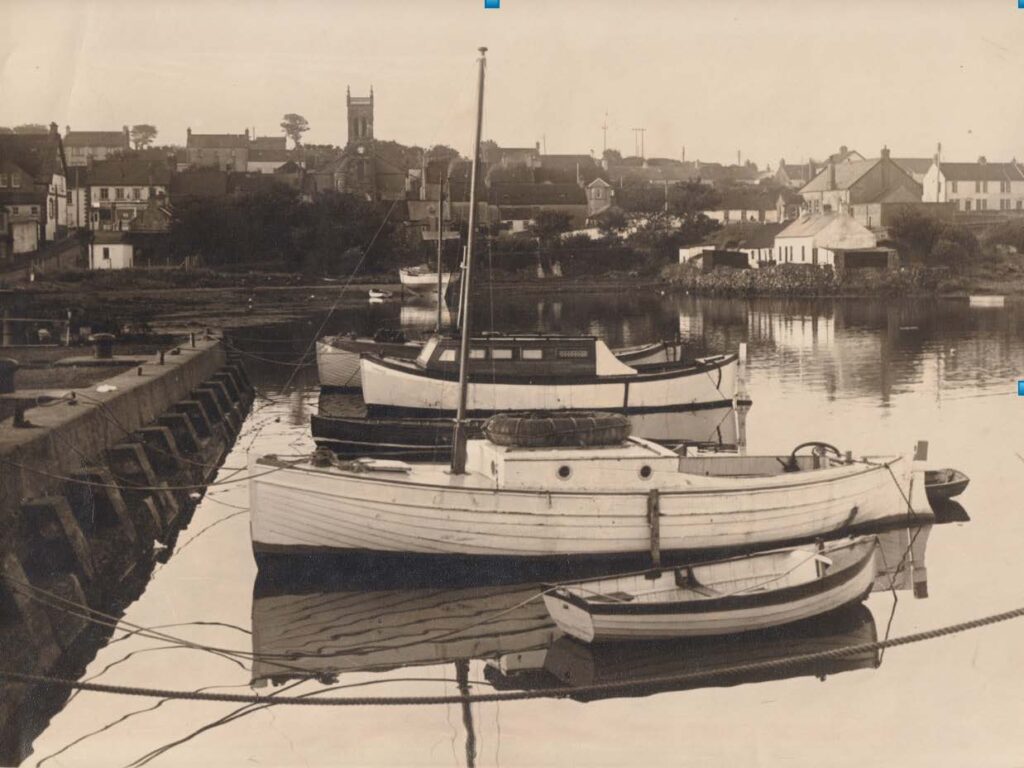
This photograph was taken by David Major, a resident of the village.
0280 Photograph supplied by Ann Gorman


Perry Moore attributes this photograph to Perry Zachary, a photographer from Belfast who had a houseboat moored in the harbour.
In the foreground is the AHC Waterson (B444). The many ropes and lines and other pieces of equipment necessary for fishing can clearly be seen.
0278 Photograph supplied by Perry Moore
If you have more information about this photo please contact discovergroomsport@gmail.com mentioning the four digit number above.


Jack McClelland attempted to swim the North Channel to Scotland. In this photograph from the County Down Spectator, 1st August 1858, he is seen shaking the hand of John Waterson, who would be his pilot on the swim. The others are, from the left, John Burns and William Angus.
0245 Newspaper extract supplied by Ann Blachford.
If you have more information about this photo please contact discovergroomsport@gmail.com mentioning the four digit number above.


The fishing boat Wee Mac was owned by Jim Nelson.
0285 Photograph supplied by Margaret Parr
If you have more information about this photo please contact discovergroomsport@gmail.com mentioning the four digit number above.

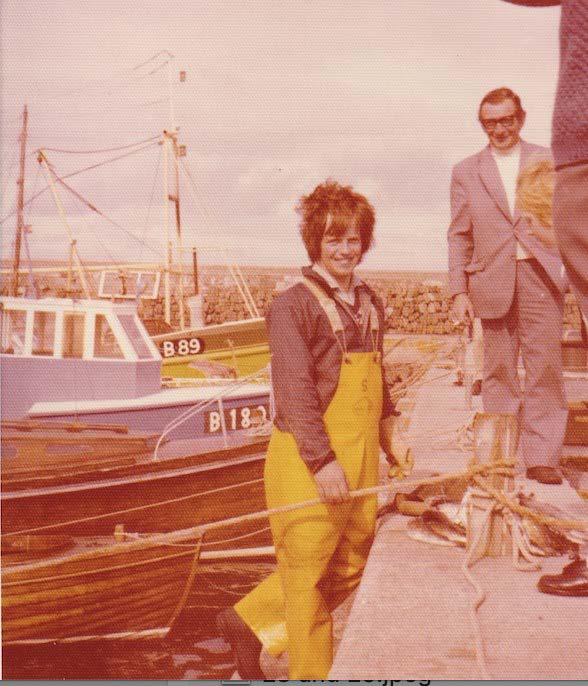
Nick worked om Jim Nelson’s Laura at weekends.
0286 Photograph supplied by Margaret Parr


0287 Photograph supplied by Margaret Parr.
If you have more information about this photo please contact discovergroomsport@gmail.com mentioning the four digit number above.

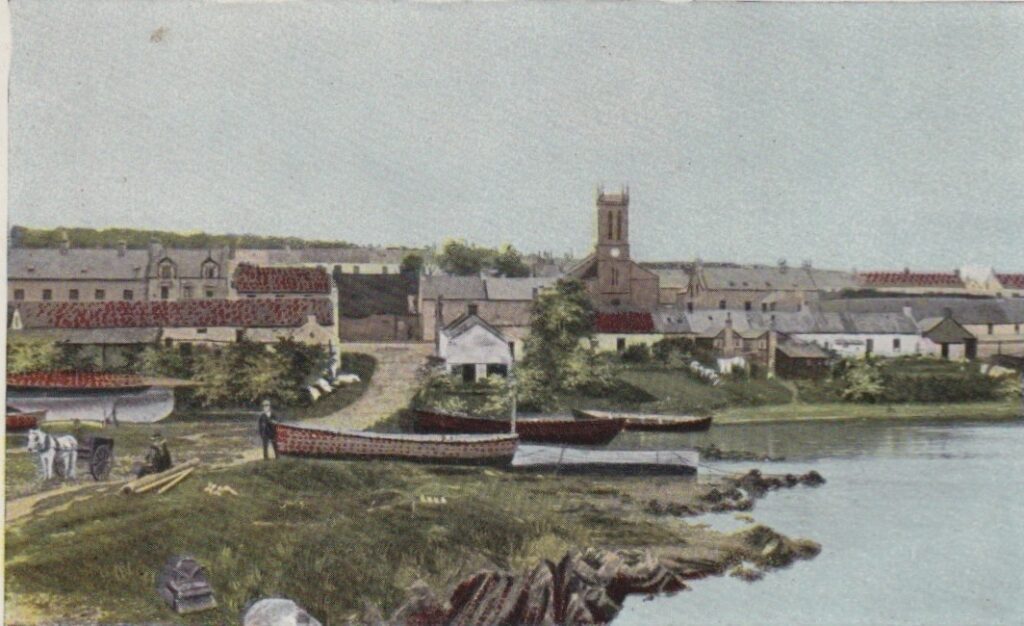
This postcard was posted in August 1912, addressed to the Temperance Hotel in Larne.
0304 Photograph supplied by Ruth Fee
